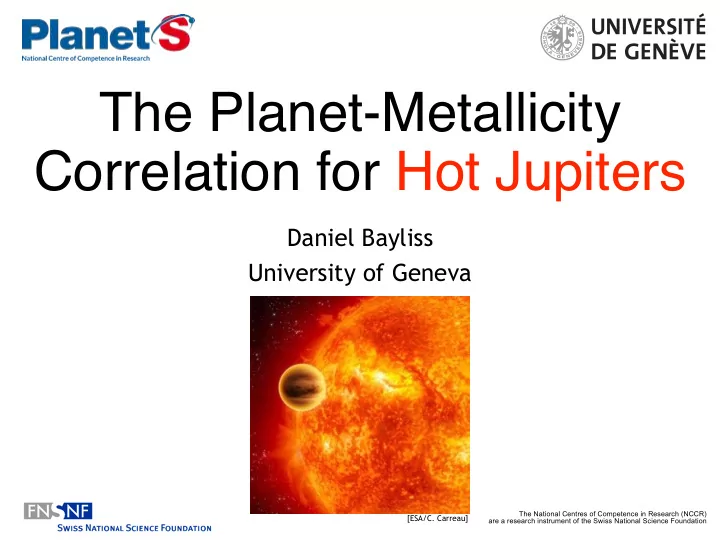

The Planet-Metallicity Correlation for Hot Jupiters Daniel Bayliss University of Geneva The National Centres of Competence in Research (NCCR) [ESA/C. Carreau] are a research instrument of the Swiss National Science Foundation
Background • After just four hot Jupiters (51 Peg, 55 Cnc, ν And, Tau-Boo), it was observed hot Jupiter host stars appeared to be unusually metal-rich [Gonzalez 1997]. • The mean metallicity of these four hot Jupiter hosts is [Fe/H]=+0.22. 2
Mayor & Queloz, 1995 3
Origin Gonzalez (1997) presented two origins for this correlation: • Self enrichment (aka pollution) - the hot Jupiter sweeps chondritic material inwards when migrates (favoured). • Primordial - giant planets form more readily in high metallicity environments. 4
Evidence for primordial origin • Santos et al. 2001 presented a volume limited sample of 43 stars from the CORALIE planet search. The [Fe/H] distribution and giant planet occurrence of this sample pointed to primordial enrichment. • This was used to support the theory of giant planet formation via core accretion, as high primordial [Fe/H] would more readily form cores. Santos et al., 2001 5
Correlation confirmed • Subsequent larger studies confirmed correlation [e.g. Santos et al. 2004, Fischer & Valenti 2005, ++ others] * * K > 30 m/s P < 4 yrs Fischer & Valenti, 2005 6
The correlation for Hot Jupiters • Hot Jupiters are intrinsically rare - from transit surveys only 0.1 to 0.4% [Gould et al. 2006, Bayliss & Sackett 2011, Howard et al. 2012] • The vast majority (~75%) of Hot Jupiters have been discovered from ground based surveys (e.g. WASP , HATNet, HATSouth, KELT , etc). • In this study we examine the metallicity correlation via the population of Hot Jupiters detected from wide-FOV ground-based surveys. 7
Advantages • Large sample size - 174 hot Jupiters. Ground based surveys have monitored ~10 6 stars (c.f. Kepler~10 5 stars, RV~10 3 stars). • Ground based surveys give a sample of Hot Jupiters free from any selection bias: • all stars in the FOV are monitored (no colour, spectral, activity, age cuts). • transit method is insensitive to planet mass. • transit method is insensitive to host star metallicity. 8
Disadvantages • Ground based surveys do not have good [Fe/H] information about all stars monitored. • Ground based detections do not make up a homogeneous sample - they cover different magnitude ranges and cover different galactic regions • We are not able to (easily) recover a “fraction of stars with planet” metric. 9
Statistical Approach • All Hot Jupiters with hosts V<15.5 from unbiased, wide-FOV transit surveys. Use SWEEP-Cat catalogue [Santos et al. 2013]. This gives a sample of 174 Hot Jupiters. • Compare each detected hot Jupiter to an ensemble of stars with similar apparent magnitude and galactic coordinates using TRILEGAL Galaxy model [Girardi et al. 2005] • Create a metric δ [Fe/H] as: δ [ Fe/H ] = [ Fe/H ] HJ − < [ Fe/H ] pop > 10
Raw metallicities of sample 0 . 8 0 . 6 0 . 4 0 . 2 <Fe/H>=0.08 [Fe/H] 0 . 0 − 0 . 2 − 0 . 4 − 0 . 6 − 0 . 8 8 9 10 11 12 13 14 15 16 V mag 11
δ metallicities of sample 0 . 8 0 . 6 0 . 4 δ <Fe/H>=0.20 0 . 2 δ [Fe/H] 0 . 0 − 0 . 2 − 0 . 4 − 0 . 6 − 0 . 8 8 9 10 11 12 13 14 15 16 V mag 12
Comparison of results • Hot Jupiters show an δ [Fe/H] of +0.20 dex • This is in remarkably close agreement to the general giant planet population: • +0.21 (Santos et al., 2003 - e<0.3) • +0.12 (Santos et al., 2003 - all e) • +0.13 (Fischer & Valenti, 2005 - all e) • +0.18 (Jofre et al., 2015 - subgiants) • +0.15 (Ghezzi et al., 2010 - slightly higher for Jupiter mass only) • +0.20 (Schlaufman & Gregory 2013 - Kepler gas giants) 13
Conclusions • Hot Jupiters detected via ground-based transit surveys represent the best sample with which to test the planet-metallicity correlation for Hot Jupiters. • The hot Jupiter metallicity enhancement is +0.20 dex - no different to the general population of gas giants (P<~4 years). • The migration mechanism that led to hot Jupiters does not appear to be dependent on the metallicity environment. 14
Extra slides 15
Transiting “giant” planets Ground 2 . 0 Space 1 . 5 Radius ( R J ) 1 . 0 0 . 5 1 2 3 4 5 Mass ( M J ) 16
Exoplanet Densities 10 1 Density (g.cm − 3 ) 10 0 10 − 1 10 − 2 10 − 1 10 0 10 1 Mass (M J ) Bayliss et al., 2015 AJ, 150, 49. 17
Recommend
More recommend